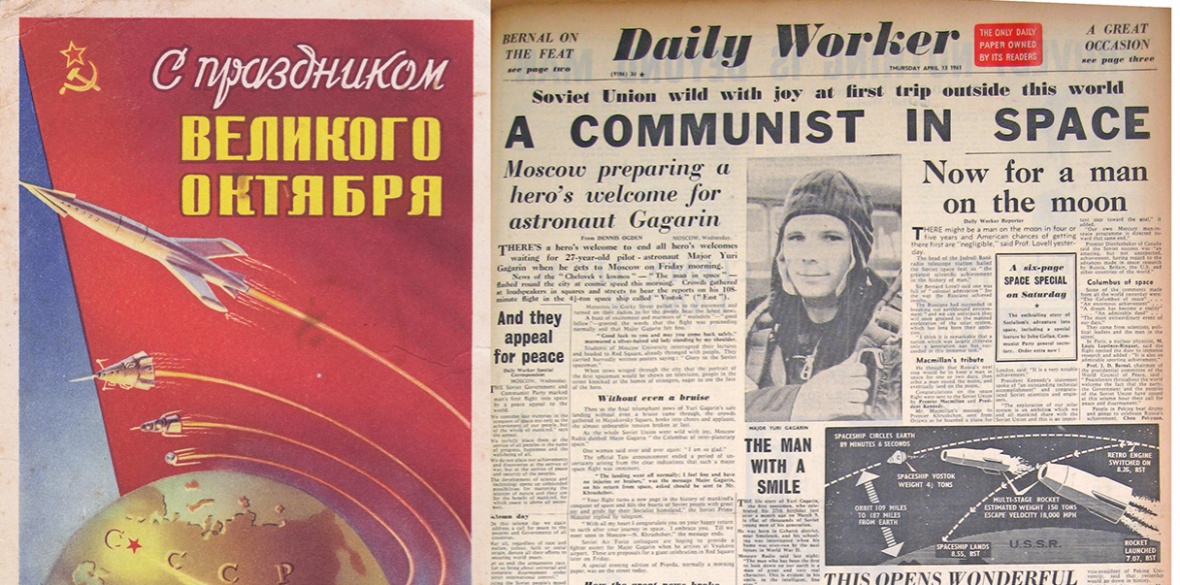This is the last article you can read this month
You can read more article this month
You can read more articles this month
Sorry your limit is up for this month
Reset on:
Please help support the Morning Star by subscribing here
THE Soviet space programme of the 1950s and 1960s may have had some military association, but its chief designer, the brilliant Sergei Korolev, had no interest in weapons developments and devoted his life to the pursuit of space travel and exploration for the sake of peaceful human advancement and the prestige of the USSR.
It is worth reminding ourselves of that fact as we celebrate Cosmonaut’s Day — a day set aside to admire the remarkable achievements of the Soviet pioneers and their successes in the 1950s and early 1960s years of the space race with the US.
The date, April 12, is that of Yuri Gagarin’s first 108-minute human flight into space in 1961. Tonight, I will be presenting on this topic to a Society For Co-operation In Russian & Soviet Studies online gathering (details below) and for doing so have already been subject of a call to boycott my books due to a false assertion that I must by implication support the Russians in the war in Ukraine.
Sad that the behaviour of the Russian Federation’s current leader should lead to a wish on the part of some to rub out memory of the Soviet experiment that ended in 1991.
The Soviet achievements that saw the first launching into space of a man-made object (Sputnik 1 in October 1957), mammal life form (Laika the dog in November 1957), human man (Yuri Gagarin in April 1960) and woman (Valentina Tereshkova in June 1963), were based around the efforts and bravery of some remarkable people.
It was the Ukrainian Korolev, a rocket engineer since the early 1930s and Gulag survivor, with astute organisational skills and the ability to convince Soviet leader Khrushchev of the significance of space pioneering in the cold war ideological race, who was at the centre.
So important was Korolev that his identity was kept secret until after his death in 1966 to protect him from US assassination or kidnap.
He was surrounded by many other scientists and engineers. Initially their efforts were based around captured German technology at the close of the war, but they soon replaced this with their own while the Americans relied on captured German scientists at the head of their developments (SS officer Wernher von Braun going on to head the US space programme).
The US only seriously began investing in peaceful (rather than weapon-based) rocketry after the humiliation of the Sputnik 1 success of 1957 — the minuscule satellite bleeping its way across the sky where it was clearly seen by bemused Americans.
Another important individual was convinced communist Boris Kamenin, a pilot hero from the 1930s whose air squadron in the second world war had included, as a pilot, his 14-year-old son.
Although a disciplinarian, he understood people and was tasked with selecting the final cohort of cosmonauts including Gagarin, and helping them negotiate inevitable and sudden international fame (if they survived — and not all did).
Gagarin himself was the son of a peasant, the family only by luck surviving the Nazi occupation of the Smolensk region of Russia.
After an apprenticeship as a steel foundry worker, Gagarin, like others, was able to use access as a Young Communist to a flying club, to improve his skills enough to join the air force and train as a fighter pilot.
After some service in the far north of Russia he was selected for cosmonaut training, although this would only become apparent gradually as numbers of recruits were whittled down through a gruelling training regime.
Gagarin’s background as the son of a peasant and his likeable charm were also factors — after all, the aim was to make he and the others worldwide ambassadors of communism and Soviet achievement.
He and his colleague Gherman Titov shone through on all scores, but Gagarin was chosen to be the first person in space, not because he was the best, but because he was the second best — Titov’s better pilot skills would be needed for the second trip which would involve more work on the cosmonaut pilot’s part.
The first woman, Tereshkova, was just as much of a character: from Yaroslavl in Russia, she was a textile worker who had already given up on her ambition to be a railway locomotive driver due to caring responsibilities.
She too was a headstrong and convinced Young Communist whose parachute club hobby saw her selected in 1962 to be one of the cohort of women, one of whom would go into space.
Not that she knew this for a long time, and her mother only found out upon Valentina’s landing back on Earth the following year.
Sadly the two colleagues who also completed training, Valentina Ponomareva and Irina Solovyeva, never got the same opportunity.
Soviet space success continued for another few years — with other notable firsts. The three pioneers were feted throughout the world including in Britain, and denied further space travel in favour of this role — despite protestations.
All fulfilled their duty admirably. However, the times were changing: the spending power of the dollar meant the US soon overtook and, of course, won the race to the moon with the successful flight of Apollo 11 in 1969.
By that time Gagarin was dead, victim of an air training accident. So too was Korolev, who had been ill for some time before fatal botched surgery in 1966.
Titov remained involved in the space programme for many years and died in 2000, by which time it was largely in private hands after the USSR’s demise.
Tereshkova, at 85 years old, never made it back into space but is active today as an elected member of the Russian Federation parliament.
The years of Soviet space achievement, and Gagarin’s infectious smile, will always be remembered, however troubled the times we live in.
Colin Turbett is author of Soviets in Space — the People of the USSR and the Race to the Moon, published in November 2021 by Pen & Sword. Tonight, April 12, he will be talking about his book at an online meeting hosted by the SCRSS. Details can be found on Eventbrite and all welcome: mstar.link/SovietsSpace.










